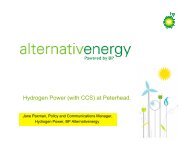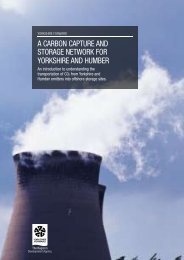Final report for One North East And NEPIC 21/12/10 - The Carbon ...
Final report for One North East And NEPIC 21/12/10 - The Carbon ...
Final report for One North East And NEPIC 21/12/10 - The Carbon ...
Create successful ePaper yourself
Turn your PDF publications into a flip-book with our unique Google optimized e-Paper software.
<strong>The</strong> case <strong>for</strong> a Tees CCS network<strong>Final</strong> ReportConsidering pipelines only, the decision should be pivoted around the design of theoffshore pipeline as this will be the largest single expenditure. In terms of the degree andtiming of CO 2 emissions reduction, a network sized solely <strong>for</strong> an anchor project offers themost limited CO 2 abatement potential. Subsequent projects would each need to developtheir own transport solution which would raise the costs and delay implementation.Conversely the Large network offers the potential <strong>for</strong> the highest CO 2 emissions reductionof CCS as the most emitters could connect to the network. <strong>The</strong> Small and Mediumnetworks offer compromise options with intermediate levels of CO 2 transport.<strong>The</strong> variable operating costs of a CO 2 pipeline are very, low, so that costs are dominatedby the capital cost and fixed operating costs. <strong>The</strong>se costs are essentially directlyproportional to the distance from the shoreline to sink. <strong>The</strong> absolute costs of a singleanchor project are the lowest of any of the networks, but the costs of repeating theinvestment in the offshore pipeline suggest that this approach would be very expensive inabsolute terms. Investing in the large network would incur the highest absolute up-frontcosts and operating costs. Clearly the Small and Medium networks offer compromiseoptions with intermediate levels of capital required.It is difficult to see how a pipeline <strong>for</strong> an anchor project only (or several point-to-pointpipelines) could ever be commercially viable, other than in the specific context of CCSdemonstration, as the cost of service <strong>for</strong> the pipeline would need to be around £<strong>12</strong>/tCO 2 .Under a „baseline‟ scenario, which assumes a discount rate of <strong>10</strong>% and economic lifetimeof 20 years, and where utilisation of the network grows gradually from 2018 to 2030, theSmall, Medium and Large networks would need to charge an average cost of service ofaround £7.4/tCO 2 to ensure economic viability. However, expectations of value <strong>for</strong> money(in terms of £/tCO 2 ) are highly sensitive to discount rate (or weighted average cost ofcapital) and utilisation assumptions. <strong>The</strong> higher the discount rate, the more likely theinvestor would need to be confident that the pipeline would be used at full capacity quickly.In terms of flexibility, there are three important considerations. <strong>The</strong> first is that the diameterof a pipeline is fixed and limits flexibility by limiting the maximum CO 2 transport capacity.Under this definition, the „Large‟ network obviously provides the most flexibility <strong>for</strong> futuresources to connect. <strong>The</strong> second is that any pipeline is a highly specific investment. Notonly is it unlikely that a CO 2 pipeline would be readily re-used <strong>for</strong> any other purpose, butthe precise location inherently dictates which stores are economically accessible. As anexample, if the pipeline is built initially directed to the saline aquifers or depleted gasfieldsin the Southern <strong>North</strong> Sea, it would be expensive later to develop a spur to connect tooilfields in the Central and <strong>North</strong>ern <strong>North</strong> Sea to participate in CO 2 -enhanced oil recovery.<strong>The</strong> third consideration is the potential flexibility to accommodate different CO 2specifications (composition, temperature, pressure etc.). Although the transport of CO 2 bypipeline is in any case likely to be highly restricted to very narrow conditions of impurities,it is nevertheless technically possible that a series of point-to-point pipelines could eachhave slightly different CO 2 specifications (instead of an integrated network which wouldnecessarily have the most restrictive entry conditions.In terms of robustness and investment risk, the principle risk here is of low utilisation,which is exacerbated when the network is built in anticipation of future sources connecting,unlike a point-to-point or Anchor only system where pipeline investment would beexpected to be fully coupled to investment in capture. <strong>The</strong> investment risk is highestthere<strong>for</strong>e <strong>for</strong> the largest network, so that Medium and Small networks may providesensible compromises if uncertainties are considered too high.32







